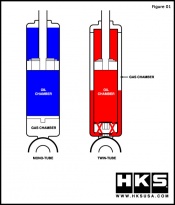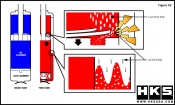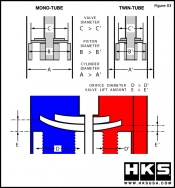Shocks: Monotube vs Twintube — различия между версиями
м (Новая страница: «Figure 1:<br />Mono-tube (or single tube) vs. Twin-tube All HKS Hipermax Suspension systems utilize a mono-tube suspension struc...») |
(нет различий)
|
Версия 23:56, 21 октября 2010
All HKS Hipermax Suspension systems utilize a mono-tube suspension structure which is a design where both the oil chamber and gas chamber are completely separated inside a single cylinder. Dampening is created as the piston moves up and down inside the cylinder. Dampening is maintained by applying constant load to the cylinder with the use of high pressure gas. There are many characteristics to the mono-tube design, which results in high durability, and comfort even in the harshest driving conditions. Mono-tube suspension structure requires an intense level of research and development as well as advanced manufacturing.Twin-tube suspension has dual oil chambers inside the cylinder, enabling the oil to move from the inner chamber to the outer chamber as the damper strokes. Subtle dampening adjustments are more difficult since the oil level is lower and piston area that receives pressure is smaller than compared to the mono-tube design. Since the cylinder is covered by an outer tube, it cannot dissipate heat well, which can cause the oil to deteriorate quicker. Twin-tube structure is commonly used by other manufacturers because of its cheaper manufacturing costs.
By isolating the oil chamber and gas chamber, aeration and cavitation that occur commonly in twin-tube designs can be greatly reduced. Thus a more comfortable ride can be obtained which cannot be imitated by a twin-tube design.
Compared to the twin-tube design, the area of the piston can be made larger on a mono-tube. By increasing the diameter of the valve and optimizing the size of the hole in the piston, it can react precisely to small bumps on the road. In result, a more comfortable and quicker reacting suspension system can be achieved.
Unlike the twin-tube design, the cylinder of the mono-tube is directly exposed to atmosphere, which aids in heat dissipation. It also carries a larger oil capacity that can make the oil last longer. Longer oil life means longer damper life.
Mono-tube suspension structure can be utilized by an inverted strut type, which cannot be imitated by a twin-tube design, the rigidity of the suspension is greatly enhanced. (If the twin-tube is flipped upside down, the oil and gas will be backwards, which may cause the gas to enter the inner cylinder. If this happens the suspension will not function properly.) When the rigidity is enhanced, handling and road contact will improve allowing better car control and stability.
(c) HKS USA


